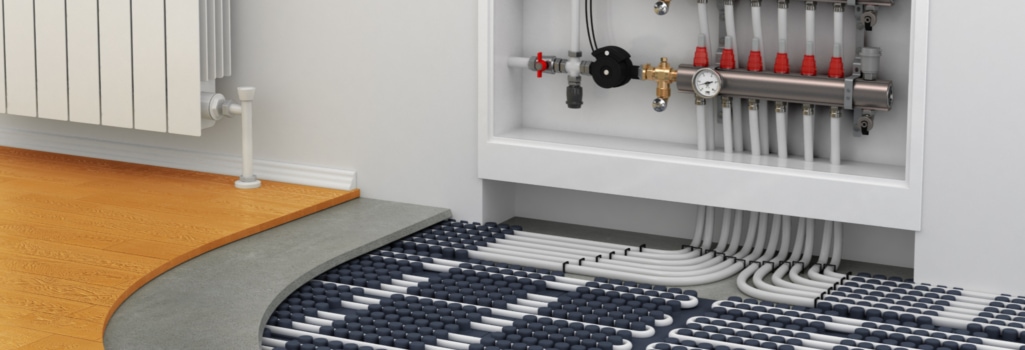Radiant Floor Heating
Radiant floor heating can be called the silent hero of home heating. Since the heat actually emanates from the floor, it is efficient and quiet, without blowing allergens throughout a home’s air. It’s not drafty, without duct work, registers, and returns involved. Radiant floor heating has the feel of standing in a window on a sunny cold day with the sun warming you, without the sun needing to warm the outside air. As the waves of thermal radiation rise from below, they warm any objects they touch in the room, which then in turn radiate that heat. Even though the air temperature remains the same, these objects are warmed and, therefore, not stealing heat from your body. There are a number of homes in the Birmingham, AL, area enjoying the benefits of radiant floor heating.
Subfloor heating has been around from the ancient Romans and Turks to Frank Lloyd Wright. The ancients used it in their homes and bath houses, heating their marble and tile floors, while Frank Lloyd Wright used copper piping in his homes, with a few postwar subdivisions implementing it as well. It fell out of use during that time due to the copper-pipe corrosion and the cost of breaking through floors for replacement. However, technology has brought PEX (cross-linked polyethylene) tubing onto the scene, eradicating the need for metal and corroding piping, making radiant floor heating an efficient and favorable choice for heating homes. Call Western Sales and Services to speak with a knowledgeable technician about this heating choice for your home.
How Radiant Floors Work
In radiant floor heating, warmth comes from hot-water tubes or electric wires buried beneath the floor. As mentioned above, the heat waves rise and warm the objects they strike. You stay warm, because these objects have their own heat and aren’t taking yours. Compare this to conventional forced-air heat, which is what most American homes have. Air blows from registers at a temperature of 120 degrees Fahrenheit, where it rises to the top of the room, then drops back down as it cools. This explains why your toes could still be cold while your head is warm. Also forced-air heating systems cycle. You turn on your furnace, it heats to the designated temperature, then it shuts off. This cycle repeats, making the temperature in your home uneven due to the series of ups and downs with the temperature. Radiant floors produce an even, constant, cost-effective heat, most effective with most types of finished flooring, including hardwood and tile. Carpet isn’t usually recommended due to the carpet’s padding beneath––it stifles the heat.
Types of Radiant Floor Heat
There are basically two types of radiant floor heat: electric and hydronic. There is a third, air-heated floor heat, but it’s not at all cost-effective in residential applications and seldom used. Feel free to call Western Sales and Services at any time for a full explanation of radiant floors and which type would best be suited to your home and budget.
Electric Radiant Heat
Electric radiant heat uses electric resistance cables beneath the flooring. Typically, electric floors are not used as a home’s main source of heat, as the relatively high cost of electricity would not make this choice cost-effective. This type of floor heat is used as supplemental heat, as in the case of an addition or a bathroom. Programmable thermostats are recommended for both air and floor-temperature limits to minimize energy costs. The electric cables are built into the floor or can be pre-attached to mats for easy installation and are installed over a subfloor in a bed of thin-set mortar. If pulling up your existing flooring isn’t an option, there are companies making electric radiant pads that fit in joist bays under the subfloor. Contact Western Sales and Services to see if this is an option for your project.
Hydronic Radiant Heat
Hydronic radiant heat systems are usually designed for an entire house. A boiler or water heater heats water to between 100 and 120 degrees Fahrenheit, and it’s circulated through tubing beneath the floors. As touched on above, PEX tubing is now the tubing of choice, as copper and metal corrode over time. This flexible tubing can be installed in a myriad of ways––on top of the subfloor in grooved panels or snap-in grids, clipped into aluminum strips on the underside of the floor, or embedded in poured concrete.
Costs of Radiant Floors
The installation of radiant floor heat costs more initially than more conventional heating systems, like forced air heating or hydronic (baseboard radiators) systems. But in the long run, it saves money due to lower thermostat settings and higher efficiency. Also, radiant floor heating does not address a home’s cooling, so that is a separate purchase to consider. As with any heating project, you need to access the materials and equipment costs, as well as the labor costs. But even assessing the initial investment needed, many residents of Birmingham, AL, are installing radiant floor heating in their homes and are blissfully happy with their choice.
Need Radiant Floor Service?
Contact the experts at Western Sales and Services.
Call us at 205-787-8674!

